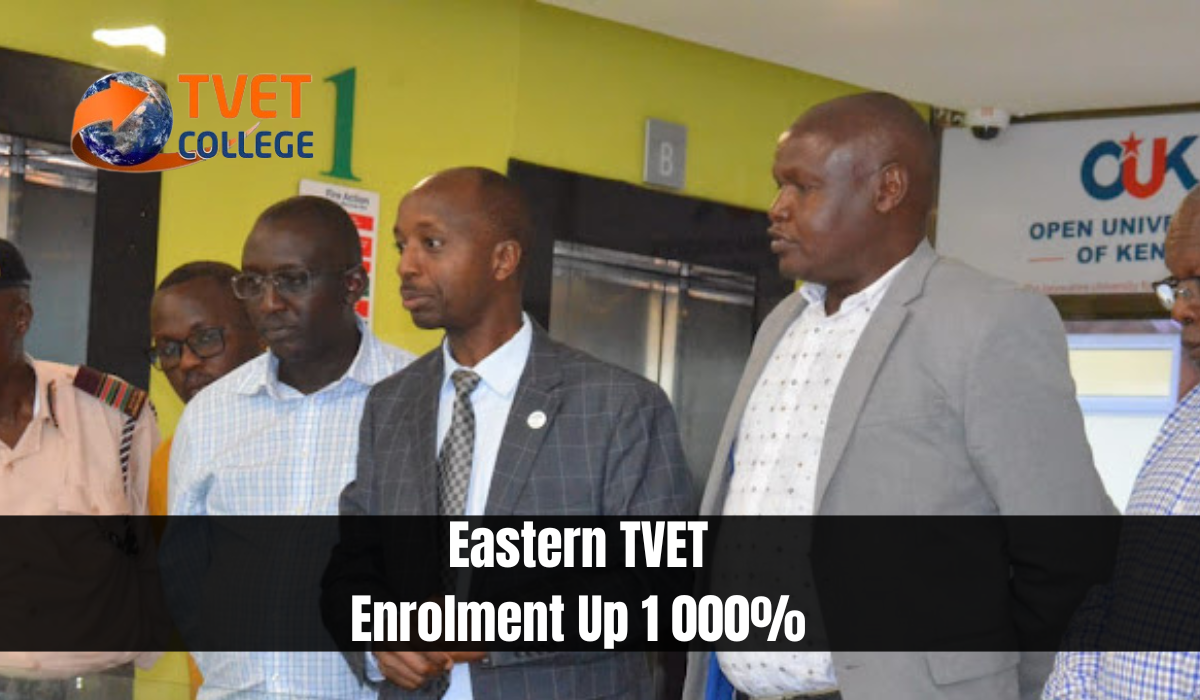Eastern TVET Enrolment Up 1 000%

Eastern TVET Enrolment Up 1 000%. In a remarkable development, Technical Vocational Education and Training (TVET) institutions in Kenya’s Eastern region have witnessed a massive surge in enrolment, with numbers skyrocketing by up to 1,000%. This revelation comes from Eastern Regional Commissioner Paul Rotich, who expressed optimism about the growing interest in TVET programs, driven by a rising demand for technical skills among youth and communities.
A 1,000% Increase in TVET Enrolment
Speaking during a tour of government projects at the Konza Technopolis City in Machakos County, Commissioner Rotich shared the astounding figures, which highlight the tremendous growth in TVET enrolment. “We are seeing up to 1,000% increase in the number of students enrolling in TVET programs. Two institutions, for example, have grown their numbers from approximately 100 students to 4,500 and 3,700 respectively,” Rotich stated.
This spike in enrolment signals a positive shift toward embracing technical education as a viable and attractive option for the youth. As job markets evolve and technical skills become increasingly essential, TVET programs provide young people with the tools they need to succeed in fields such as construction, engineering, ICT, and more.
The Role of TVET in Empowering Youth
TVET programs have long been recognized for their ability to equip learners with practical, hands-on skills that are directly applicable to industries experiencing rapid growth. The Eastern region’s significant enrolment increase demonstrates the growing recognition of TVET’s value. More young people are choosing these programs to secure sustainable employment opportunities and contribute to the development of their communities.
Commissioner Rotich praised the rising demand for TVET education, underscoring its critical role in driving economic growth. “Technical education has the potential to transform the lives of our youth. With this surge in enrolment, we are empowering a generation with skills that are in high demand, particularly in technical fields that are shaping the future of Kenya’s economy,” he noted.
Konza Technopolis and TVET Growth
Rotich’s comments came during a visit to Konza Technopolis, a city that is being developed as a smart city with a focus on technology, innovation, and education. The ongoing construction work at Konza Technopolis, particularly its ICT and industrial sectors, is poised to create numerous employment opportunities for TVET graduates.
Projects like Konza Technopolis are aligned with Kenya’s Vision 2030, which emphasizes the role of technology, education, and industrialization in national development. The increasing TVET enrolment in Eastern Kenya is expected to produce a workforce that can support the ambitious goals of these projects, contributing to both local and national progress.
Commitment to Timely Project Delivery
During the tour, Commissioner Rotich reiterated his commitment to ensuring that government projects in the region are delivered on time and meet the highest standards of accountability. He emphasized the importance of proper oversight to prevent delays and mismanagement in critical projects such as Konza Technopolis.
“I assure our citizens that I am serious about the work we have been entrusted with. Every penny invested in development projects must be accounted for, and we are committed to delivering value for money,” Rotich stated.
The tour also involved officials from various government departments, including the office of Prime Cabinet Secretary Musalia Mudavadi, who joined the delegation to review the progress of ongoing projects. Among the projects visited were the 4,118-unit affordable housing initiative in Athi River, Kinanie Leather Industrial Park EPZ, Konza City Special Economic Zone, and the refurbishment of the Machakos County Commissioner’s offices.
Addressing Challenges in Project Implementation
Despite the success of TVET enrolment and other regional developments, Commissioner Rotich acknowledged that challenges remain, particularly in the timely completion of government projects. Financial flows have posed significant hurdles in sectors such as agriculture and infrastructure, impacting the pace of progress.
“Financial challenges have hindered the implementation of some projects. In the agriculture sector, for instance, there are issues related to the availability of inputs for farmers. The road sector has also experienced delays due to funding issues,” Rotich explained.
However, he expressed confidence that the government is working to resolve these issues and deliver on its promises to the people. “The promises made by the government and our development plans are enormous. Once we succeed in completing these projects, we will meet the public’s expectations,” he said.
Public Perception and Accountability
Commissioner Rotich also addressed concerns over public perceptions of the government’s efforts. He noted that while some may believe that not enough is being done, the government has, in fact, made significant strides in development. The ongoing monitoring and evaluation of projects aim to correct these misconceptions and provide transparency.
“We want to erase the emerging notion that the government is doing nothing. In reality, the government has done a lot, and we are committed to engaging with the public to showcase our achievements,” Rotich remarked.
Strengthening TVET Role in Economic Growth
As Eastern Kenya continues to witness a remarkable surge in TVET enrolment, the government remains focused on ensuring that the region’s infrastructure, education, and industrial projects are completed efficiently. The 1,000% increase in TVET enrolment serves as a testament to the region’s embrace of technical education and its potential to drive economic growth.
The future looks promising for TVET graduates, who will be equipped with the necessary skills to contribute to the development of vital projects like Konza Technopolis, as well as other national initiatives in agriculture, ICT, and industrialization.
Conclusion
The 1,000% increase in TVET enrolment in Kenya’s Eastern region is more than just a statistic—it’s a reflection of the changing landscape of education and employment in the country. As more young people recognize the value of technical education, they are positioning themselves to be key contributors to Kenya’s economic future. With the government’s ongoing commitment to timely and accountable project delivery, the Eastern region is set to become a hub of innovation, industry, and opportunity for the nation’s youth.






